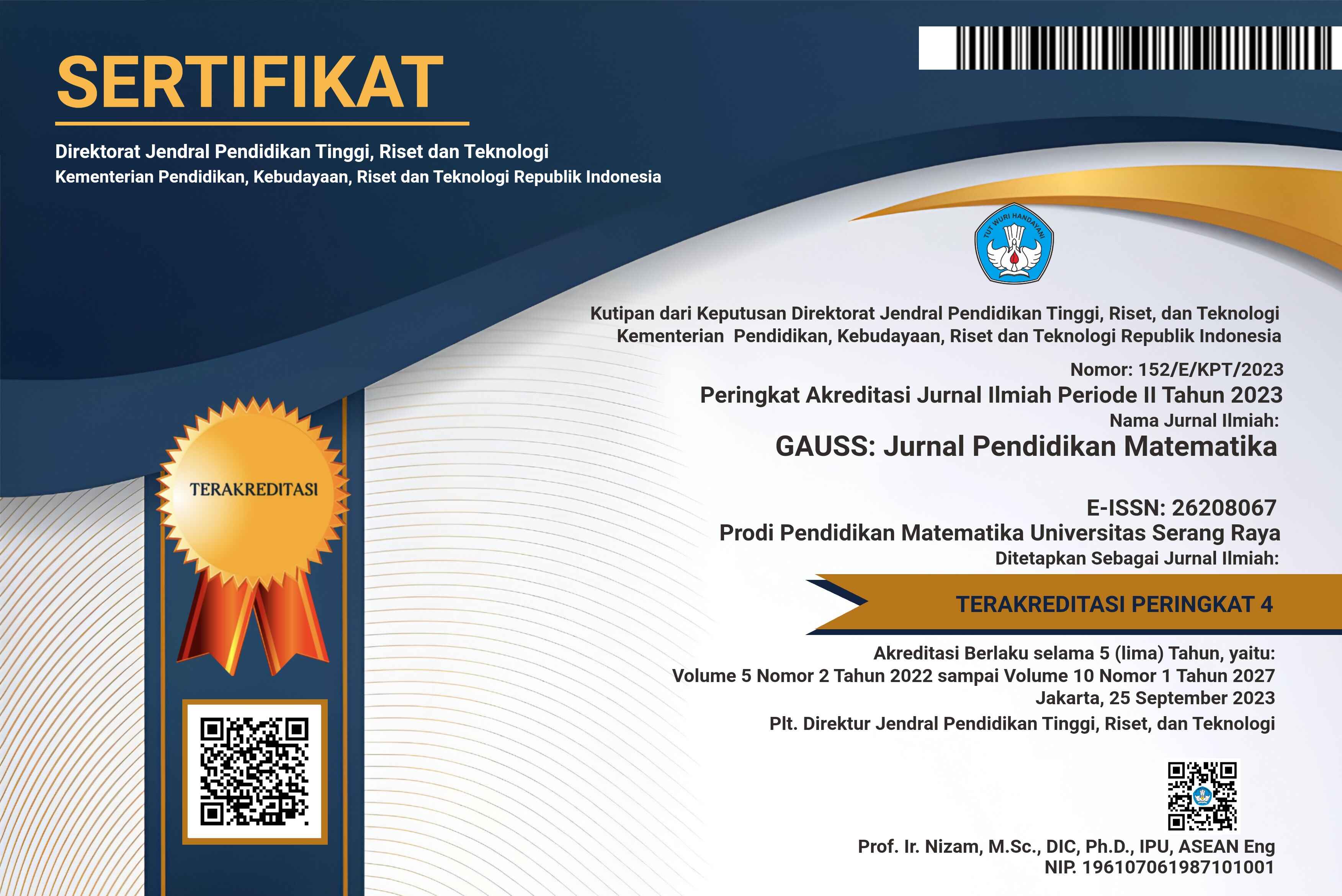Meningkatkan Kemampuan Literasi Matematis dengan Pendekatan Metacognitive Guidance Berbantuan GEOGEBRA
DOI:
https://doi.org/10.30656/gauss.v1i1.636Keywords:
Metacognitive Guidance, GeoGebra, Mathematical LiteracyAbstract
The purpose of this research was to investigate the effects of Metacognitive Guidance Approach assisted by GeoGebra on mathematical literacy. In particular, the study compares two learning environment: a) conventional learning, and b) metacognitive guidance learning using GeoGebra. This study was carried out on student‟s ability level (low, medium and high ability group), and their competence on mathematical literacy. This research was non equivalent pretest – postest - control group design. The results of data analysis showed that: 1.a) the students who were exposed to MG+GeoGebra outperform students that were not exposed to MG+GeoGebra on mathematical literacy; 1.b) the students in high and medium ability group who were exposed to MG+GeoGebra outperform students that were not exposed to MG+GeoGebra on mathematical literacy; 2) there was no interaction between learning method and student‟s ability level on mathematical literacy.References
Bandura, A. (1993). Perceived self-efficacy in cognitive development and functioning. Educational Psychologist Journal, 28(2), hlm. 117-148.
BSNP. (2006). Model KTSP dan model silabus mata pelajaran. Jakarta: BP.Cipta Jaya.
Flavell, J.H. (1979). Metacognition and cognitive monitoring: A new area of cognitive-developmental inquiry. American Psychologist Journal, 34(10), hlm. 906-911.
Mahmudi, A. (2011). Pemanfaatan GeoGebra dalam Pembelajaran Matematika, (Online), (http://staff.uny.ac.id/sites/default/files/Makalah%2017%20Semnas%20LPM%20UNY%202011%20_Pemanfaatan%20GeoGebra%20dalam%20Pembelaj aran%20Matematika_.pdf, diakses tanggal 26 November 2014).
OECD. (2013). PISA 2012 assessment and analytical framework: Mathematics, reading, science, problem solving and financial literacy. Paris: OECD Publishing.
Oktaviyanthi, R. dan Supriani, Y. (2015). Utilizing Microsoft Mathematics in Teaching and Learning Calculus. Journal on Mathematics Education, (6) 1, (Online) (http://jims-b.org/wp-content/uploads/2015/03/7-Full-IndoMS- JME-61-Rina-Oktaviyanthi.pdf, diakses 01 Agustus 2016).
Oktaviyanthi, R., Agus, R. N. dan Supriani, Y. (2015). Pisa Mathematics Framework dalam Penelusuran Mathematical Literacy Skills Mahasiswa. Jurnal Ilmu Pendidikan STKIP Kusuma Negara, (7) 1, hlm. 77-85, (Online), (https://osf.io/preprints/inarxiv/z2qsf/, diakses 01 Agustus 2016).
Oktaviyanthi, R. dan Herman, T. (2016, Oktober). A Delivery Mode Study: The Effect of Self-Paced Video Learning on First-Year College Students’ Achievement in Calculus. Artikel dipresentasikan pada The 4th International Conference on Quantitative Sciences and Its Applications, Universiti Utara Malaysia, Putrajaya, Malaysia. (Online), (http://aip.scitation.org/doi/abs/10.1063/1.4966102, diakses 01 Januari 2016).
Oktaviyanthi, R., Safaah, E., dan Agus, R. N. (2017). Pemberdayaan Keterampilan Guru Matematika dalam Menyusun Bahan Ajar Berbantuan Mathematics Education Software. Jurnal Pengabdian Masyarakat Wirakrama Parahita, (1) 1, 19-24. (Online), (http://e-jurnal.lppmunsera.org/index.php/parahita/article/view/270/523, diakses 10 Januari 2018).
Osborne, J. & Monk, M. (2000). Good practice in science teaching. London: McGraw-Hill International.
Pratiwi, D. dan Syah, A. A. (2011). Pendekatan metakognitif dalam pembelajaran matematika. Dalam: Ahmad, S, dkk. (Penyunting). Prosiding Seminar Nasional Pendidikan Universitas PGRI Palembang (hlm. 342-348). Palembang.
Sarwiko, D. (2010). Pengembangan media pembelajaran berbasis multimedia interaktif menggunakan Macromedia Director MX (Studi Kasus Mata Kuliah Pengolahan Citra pada jurusan S1 Sistem Informasi). Skripsi tidak diterbitkan. Jakarta: Universitas Gunadarma.
Steen, L. A. (1997). The new literacy: Why numbers count, quantitative literacy for tomorrow's america. The College Entrance Examination Board. New York: The College Board.
Stacey, K. (2012). Mathematical and scientific literacy around the world. Journal of Science and Mathematics Education in Southeast Asia, 33(1), 1-16.
Supriani, Y. dan Oktaviyanthi, R. (2014). The Influence of Compact Disk Interactive Learning Model and Student’s Creativity Toward the Understanding of Mathematics Concepts. International Journal of Education and Research, 2 (7), 535-540. (Online), (https://pdfs.semanticscholar.org/cee1/6135957251054ceb0e686eb0bf5d31fcc0fa.pdf, diakses 10 Agustus 2016).
Sutama. (2008). Pengembangan model pembelajaran matematika dengan pendekatan aptitude treatment interaction berbasis fortopolio di SMP kota Surakarta. Skripsi tidak diterbitkan. Universitas Muhammadiyah Surakarta, Surakarta.
Maryanti, E. (2012). Peningkatan literasi matematis siswa melalui pendekatan metacognitive guidance. Tesis tidak diterbitkan. Sekolah Pascasarjana, Universitas Pendidikan Indonesia, Bandung.
McGuinness, C. (1999). From Thinking Skills to thinking classrooms: a review and evaluation of approaches for developing pupils’ thinking. London: DfEE, (Research Report RR115), (Online), (http://www.dfes.gov.uk/research/data/uploadfiles/RB115.doc, diakses 26 November 2014).
Downloads
Published
Issue
Section
License
Authors who publish articles in GAUSS : JURNAL PENDIDIKAN MATEMATIKA agree to the following terms:
- Authors retain copyright and grant the journal the right of first publication with the work simultaneously licensed under a Creative Commons Attribution-ShareAlike 4.0 International License that allows others to share the work with an acknowledgment of the work's authorship and initial publication in this journal.
- Authors are able to enter into separate, additional contractual arrangements for the non-exclusive distribution of the journal's published version of the work (e.g., post it to an institutional repository or publish it in a book), with an acknowledgment of its initial publication in this journal.
- Authors are permitted and encouraged to post their work online (e.g., in institutional repositories or on their website) before and during the submission process, as it can lead to productive exchanges, as well as earlier and greater citation of published work (See The Effect of Open Access).




